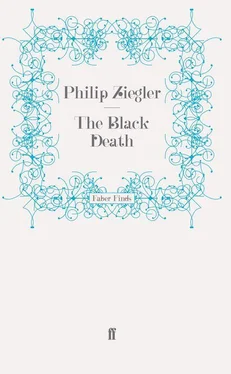The three great centres for the propagation of the plague in Southern Europe were Sicily, Genoa and Venice. It seems to have arrived more or less simultaneously at the latter ports some time in January, 1348. But it was Pisa, attacked a few weeks later, {73} 73 5 Monumenta Pisana, Muratori 15, (1729 edition), p. 1021.
which provided the main point of entry to Central and Northern Italy. From there it moved rapidly inland to Rome and Tuscany. It had begun the march which was not to end until the whole continent of Europe had been blanketed by death.
In Italy the previous years had provided a chapter of disasters less dramatic but little less damaging than those which had overtaken the unfortunate Chinese. A crescendo of calamity was reached shortly before the plague arrived. {74} 74 6 Sismondi, Histoire des Républiques Italiennes du Moyen Age, Paris, 1826, Vol. VI, p. 11 et seq.
Earthquakes had done severe damage in Naples, Rome, Pisa, Bologna, Padua and Venice. The wine in the casks had become turbid: ‘a statement which,’ as the nineteenth-century German historian Hecker hopefully remarked, ‘may be considered as furnishing a proof that changes causing a decomposition of the atmosphere had taken place.’ From July 1345 six months of almost continuous rain had made sowing impossible in many areas. The following spring things were little better. The corn crop was less than a quarter of the usual and almost all the domestic fowls had to be slaughtered for want of feeding stuffs. Even for the richest states and cities it was difficult to replace the loss by imports. ‘In 1346 and 1347 there was a severe shortage of basic foodstuffs… to the point where many people died of hunger and people ate grass and weeds as if they had been wheat.’ {75} 75 7 Storie Pistoresi, Muratori. 11, V, p. 224.
Near Orvieto the bridges were washed away by the floods and the damage done to communications all over Italy made the work of feeding the hungry still more difficult. {76} 76 8 Carpentier, Une Ville devant la Peste, op. cit., pp. 79–81.
Inevitably prices soared. The price of wheat doubled in the six months prior to May 1347, and even bran became too costly for the poor. In April 1347 a daily ration of bread was being issued to 94,000 people in Florence; prosecutions for all minor debts were suspended by the authorities and the gates of the prisons thrown open to all except serious criminals. It is said that four thousand Florentines died either of malnutrition or from diseases which, if malnutrition had not first existed, would never have proved fatal. {77} 77 9 Sismondi, op. cit., p. 13.
And yet of all the cities of Italy, Florence, with its great wealth, its powerful and sophisticated administration and its relatively high standards of education and of hygiene, was best equipped to cope with the problems of famine and disease.
Financial difficulties in Florence and Siena, which the agricultural problem complicated but did not create, made things even worse. The great finance house of the Peruzzi was declared bankrupt in 1343, the Acciaiuoli and the Bardi followed in 1345. By 1346 the Florentine houses alone had lost 1.7 million florins and virtually every bank and merchant company was in difficulties. It was an economic disaster without precedent. {78} 78 10 Giovanni Villani, Cronica, Florence, 1845, Book 12, p. 92.
Even if the grain had been available it would have been hard for the cities of Tuscany to find the money to purchase it.
The final and perhaps the most dangerous element in this sombre picture was the political disorder which was an almost invariable feature of fourteenth-century Italy. There were, said Professor Caggese, {79} 79 11 Cambridge Mediaeval History, Vol. VII, pp. 49–77.
no ‘events of universal import’ but only a multiplicity of ‘local dramas’. These dramas turned Italy into a bloody patch-work of bitter and seemingly unending squabbles. The Guelphs fought the Ghibellines, the Orsini fought the Colonna, Genoa fought Venice, the Visconti fought everybody and marauding German freebooters preyed on what was left. Rome was demoralized by the disappearance of the Papacy to Avignon and shaken by the revolution of Rienzo. Florence had recently experienced the rising of Brandini. Naples was in turmoil as Lewis of Hungary pursued his vendetta against Queen Joanna, the murderer of his brother.
For the nobles and the warriors there was, at least, glamour, excitement and a chance of booty. For the common people there was nothing except despairing fear, a total and disastrous lack of confidence in what the future might hold for them. What has been argued of Europe as a whole is, a fortiori , true of Italy. The people were physically in no state to resist a sudden and severe epidemic and psychologically they were attuned to an expectation and supine acceptance of disaster. They lacked the will to fight; almost, one might think, they welcomed the termination of their troubles. To speak of a collective death-wish is to trespass into the world of metaphysics. But if ever there was a people with a right to despair of life, it was the Italian peasantry of the mid-fourteenth century.
* * *
‘Oh, happy posterity,’ wrote Petrarch of the Black Death in Florence, ‘who will not experience such abysmal woe and will look upon our testimony as a fable.’ {80} 80 12 Epistolaé Familiares, lib. VIII, pp. 290–303.
The Black Death is associated more closely with Florence than with any other city; so much so that in contemporary and even more recent accounts it is sometimes referred to as ‘The Plague of Florence’. Partly this is because Florence at that period was one of the greatest cities of Europe and certainly the first of them to feel the full force of the epidemic. Partly it is because the plague raged there with exceptional intensity; certainly more severely than in Rome, Paris or Milan and at least as violently as in London or Vienna. But most of all Florence owes its notoriety to the terms in which its sufferings were described. In his introduction to The Decameron Boccaccio wrote what is undoubtedly and deservedly the best-known account of the Black Death and probably the most celebrated eye-witness account of any pestilence in any epoch. {81} 81 13 Defoe’s account of the Plague of London is an obvious rival but, since he was only seven years old in 1665, the term ‘eye-witness’ is perhaps loosely employed. The translation is that of J.M. Rigg in the Everyman edition (London, 1930).
One or two sentences from it have already appeared in this book but no account of the Black Death would be complete unless it were quoted extensively.
‘In Florence,’ wrote Boccaccio,
despite all that human wisdom and forethought could devise to avert it, as the cleansing of the city from many impurities by officials appointed for the purpose, the refusal of entrance to all sick folk, and the adoption of many precautions for the preservation of health; despite also humble supplications addressed to God, and often repeated both in public procession and otherwise, by the devout; towards the beginning of the spring of the said year the doleful effects of the pestilence began to be horribly apparent by symptoms that shewed as if miraculous.
…Which maladies seemed to set entirely at naught both the art of the physician and the virtues of the physic; indeed, whether it was that the disorder was of a nature to defy such treatment, or that the physicians were at fault – besides the qualified there was now a multitude both of men and women who practised without having received the slightest tincture of medical science – and, being in ignorance of its source, failed to apply the proper remedies; in either case… almost all… died, and in most cases without any fever or other attendant malady…
Читать дальше












